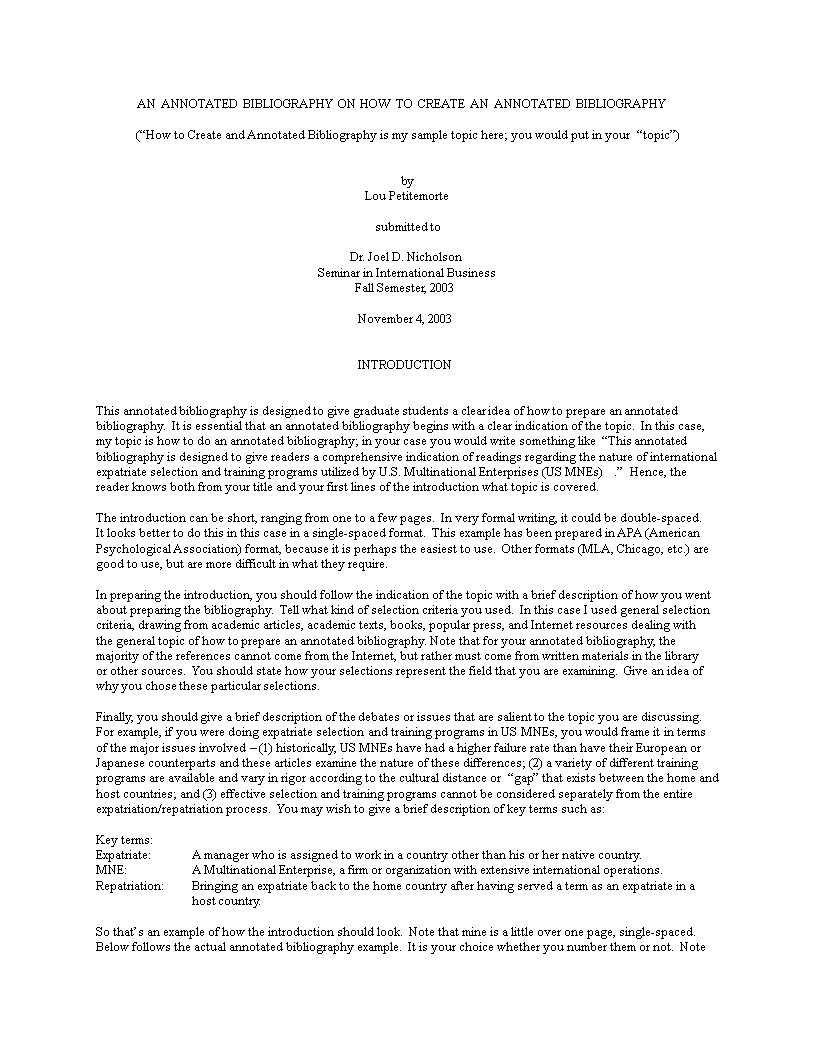Teaching Annotated Bibliography
Sponsored Link免费模板 保存,填空,打印,三步搞定!

Download Teaching Annotated Bibliography
微软的词 (.doc)免费文件转换
- 本文档已通过专业认证
- 100%可定制
- 这是一个数字下载 (71 kB)
- 语: English
Sponsored Link
What are the 3 parts of an annotated bibliography? How do you write an annotated bibliography in education? Download this sample template and use it as a guide when creating your own annotated bibliography. Make sure to provide a summary for each source and include a reflection of how it relates to your project.
A Teaching Annotated Bibliography is a resource used by educators, typically in the field of education, to provide information and guidance to students or fellow educators about a specific topic or subject area related to teaching and learning. It consists of a list of carefully selected sources (such as books, articles, reports, websites, and educational materials) accompanied by annotations or summaries that describe the content, relevance, and significance of each source.
An annotated bibliography typically consists of three main parts for each source entry:
- Citation: The citation is the first part of an annotated bibliography entry and provides the full bibliographic information for the source. This information allows readers to locate the source if they wish to access it for further reading or research. The citation includes details such as:
- Author(s) or editor(s) names
- Title of the source (article, book, website, etc.)
- Title of the larger work (if applicable, e.g., a journal or book title)
- Publication date
- Page numbers (for articles or book chapters)
- Publisher (for books)
- DOI (Digital Object Identifier) or URL (for online sources)
- Summary or Annotation: The second part of an annotated bibliography entry is the summary or annotation. This part provides a brief and concise summary of the source's content and key points. It typically includes:
- A summary of the main topics or themes covered in the source.
- A description of the source's methodology (if applicable, such as in research articles).
- A mention of the source's key findings or arguments.
- Any special features or unique contributions of the source.
- The summary or annotation should be informative but concise, usually ranging from 100 to 200 words.
- Evaluation or Reflection: The third part of an annotated bibliography entry is the evaluation or reflection section. This part offers the author's critical assessment of the source's quality, relevance, and significance. It may include comments on:
- The source's credibility and authority (e.g., the author's qualifications).
- The source's limitations or biases.
- How the source contributes to the reader's understanding of the topic.
- Any noteworthy strengths or weaknesses of the source.
- The evaluation provides context for why the source is included in the annotated bibliography and helps readers assess its value.
These three parts work together to provide readers with a concise but comprehensive overview of each source in the annotated bibliography. The citation allows readers to locate the source, the summary provides an overview of its content, and the evaluation offers insights into its quality and relevance.
To write an annotated bibliography in education, follow these steps:
- Select Your Sources:
- Choose relevant and credible sources (books, articles, websites) related to your topic in education.
- Create the Citation:
- Write each source's citation in the appropriate citation style (e.g., APA, MLA).
- Write the Summary:
- For each source, provide a concise summary (around 100-200 words) that outlines the main topics, methodology (if applicable), key findings, and any unique aspects of the source.
- Include an Evaluation:
- Evaluate the source's quality, relevance, and credibility.
- Discuss any limitations or biases.
- Explain how the source contributes to your understanding of the topic.
- Organize Entries:
- Arrange the annotated entries alphabetically by author's last name or in another specified order.
- Format and Style:
- Format the annotated bibliography according to the citation style (e.g., APA).
- Use a hanging indent for each entry.
- Proofread and Edit:
- Review your annotated bibliography for clarity, accuracy, and consistency.
- Correct any grammar or formatting errors.
- Cite Your Sources:
- If you use information or ideas from the annotated bibliography in your research or writing, cite the original sources properly.
- Title and Introduction (Optional):
- Include a title for your annotated bibliography that reflects the topic.
- Optionally, include a brief introduction explaining the purpose and scope of the bibliography.
- Final Review:
- Review your annotated bibliography one last time before submission to ensure it meets all requirements.
Remember that the specific format and requirements for an annotated bibliography may vary based on your instructor's or institution's guidelines. Always follow the specific instructions provided for your assignment or research project.
Download this Teaching Annotated Bibliography template now for your own benefit!
DISCLAIMER
Nothing on this site shall be considered legal advice and no attorney-client relationship is established.
发表评论。 如果您有任何问题或意见,请随时在下面发布
相关文件
Sponsored Link

